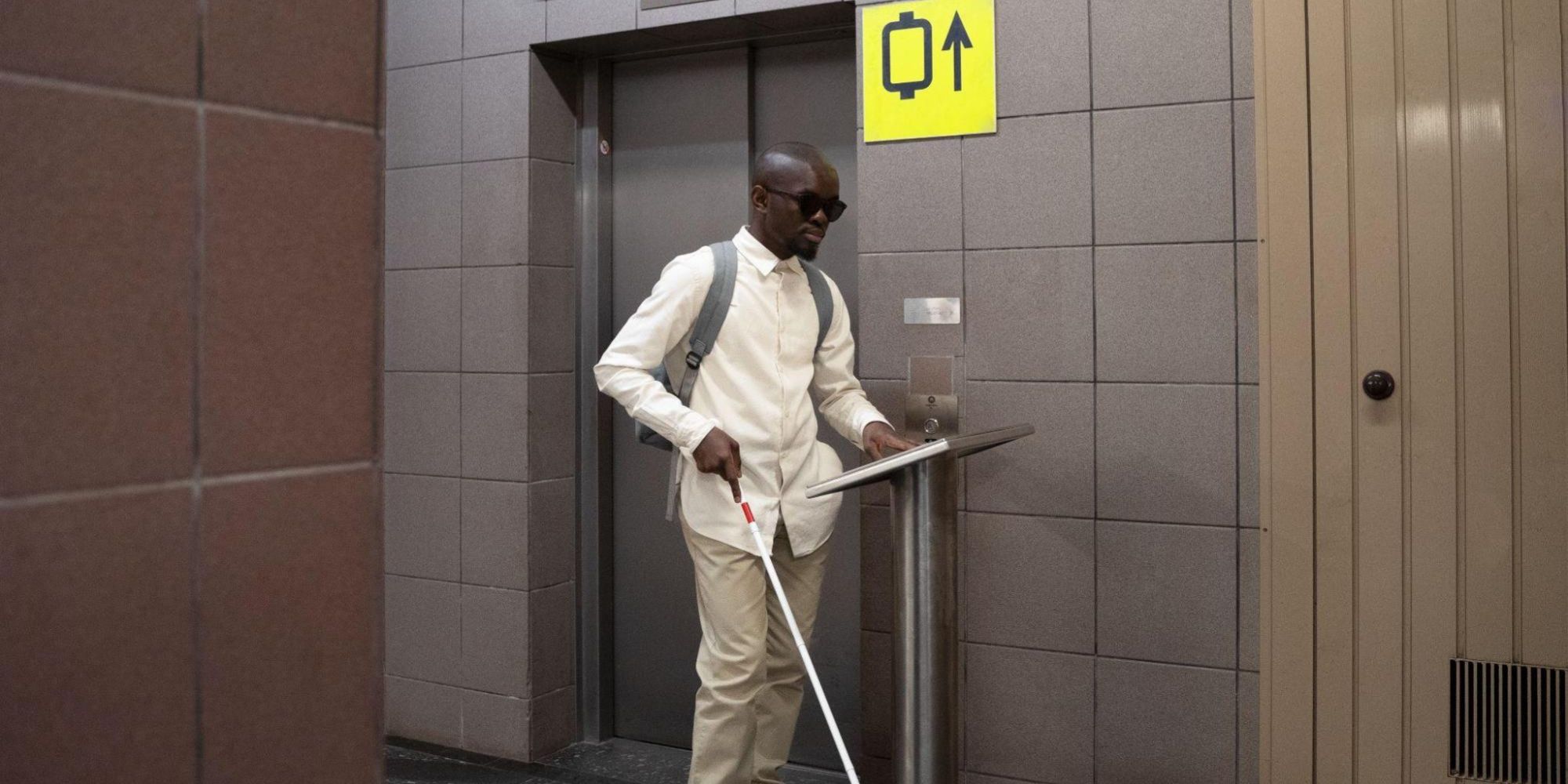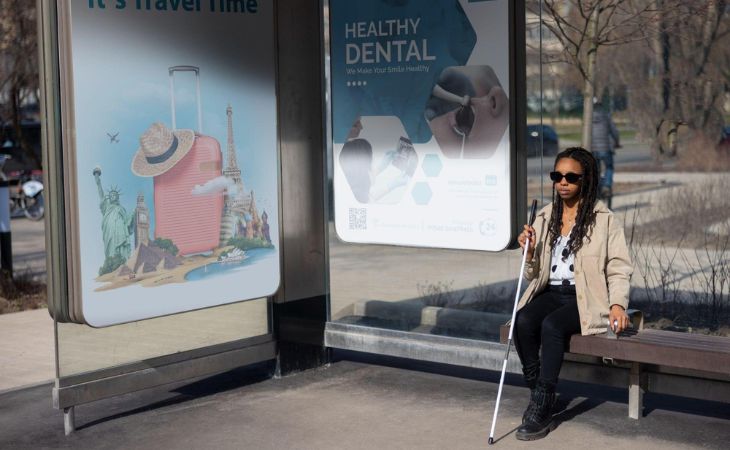
Digital Signage for Blind and Visually Impaired
With its dynamic displays and eye-catching content, digital signage has always been a powerful visual tool. It is primarily designed to harness the visual processing power of the brain, which can process visual information 60,000 times faster than text.
Nowadays, however, the call for inclusivity has created advancements in digital signage technology, making it more accessible to the blind and visually impaired. Here, we explore the digital signage move towards accessibility and reveal the key features that make digital signage more inclusive to individuals with visual impairments.
What is Accessible Digital Signage and Why Is It Important?
According to the World Health Organization (WHO), 2.2 billion people worldwide have near or distant vision impairment — that’s more than a quarter of the global population. With so many unable to enjoy the visual benefits of digital signage, it becomes apparent that digital signage technology faces innovation and becomes more inclusive for the visually impaired.
Accessible digital signage aims to do just that. Catering not just to the blind and visually impaired but to all individuals with disabilities, accessible digital signage ensures that:
- Information is readily available.
- There is no barrier to receiving that information.
- The information is communicated with all types of users in mind (including the blind, differently-abled, elderly, and marginalized groups).
Key Features of Accessible Digital Signage for the Blind and Visually Impaired

Accessibility, in the context of digital signage, requires the addition of key features that support individuals with disabilities. Here are some ways that digital signage is being made to cater to the visually impaired.
Customized Display Settings
To make digital signage accessible, it needs to be customizable to suit the needs of differently-abled individuals. The good news is that digital signage technology is becoming more flexible, giving users the option to personalize the display to cater to accessibility needs.
To make your digital signage screen friendly for the visually impaired, you can customize your display to improve contrast, increase font size, and change color settings. Adjusting the screen’s tilt or mellowing down ambient lighting can also be valuable to optimize screen brightness and reduce glare.
These small changes can go a long way in making digital signs more readable, comfortable, and accessible for those with visual disabilities.
Haptic Digital Signage
Haptic digital signage uses vibrations to communicate information. It adds a tactile experience to the display, which can help visually impaired individuals feel the content shown on a digital signage screen.
Haptic digital signage takes advantage of nearby vibration-generating devices to facilitate the tactile experience. This can be a valuable addition in transportation hubs to provide directional cues and assist in wayfinding.
Location-based Information & Real-Time Updates
To help them navigate their surroundings with ease and confidence, individuals with visual impairments will appreciate digital signage that provides them with real-time updates and location-based information.
This can come in the form of notifications, emergency alerts, and public transportation schedules, among others, communicated in a format accessible to them. Whether relayed through audible or tactile feedback, this information can be invaluable for the comfort and safety of the visually impaired.
Simple Language
Complex language design can make it difficult to translate visual information into a format accessible to the visually impaired. To make it easy to create accessible and inclusive digital signage, it would be helpful to use simple language, avoiding technical jargon, complex sentences, and idiomatic expressions.
This can also be beneficial for individuals with cognitive disabilities or those who speak a different language. Language use can spell the difference between being able to relay your message effectively or creating confusion and miscommunication.
Tactile Feedback & Braille Integration

The blind and visually impaired receive messages in Braille. This makes it a non-negotiable for accessible digital signage. Braille integration in digital signage installations can make visually impaired audience interactions with the screen more inclusive, allowing them to access textual information in their primary mode of gathering information.
Another feature that can be added is tactile feedback, which makes it possible for the visually impaired to interact with a digital sign and locate different sections of the content, empowering them to participate in the digital signage experience.
Visual-to-Audio Conversion
Digital signage traditionally focuses on communicating messages using captivating visuals. But to be able to cater to the visually impaired, it needs to convert visual information into audio formats.
This can be done with existing digital signage technologies, such as text-to-speech software that enables the audience to receive audio descriptions of digital signage content.
The software can be integrated with their smartphones or dedicated audio devices, through which they can access digital signage content in real-time, whether it be announcements, important alerts, directions, or other information about their surroundings.
Challenges with Accessible Digital Signage
Accessible digital signage is a must in this era where calls for inclusivity are getting stronger than ever. But that’s not to say adapting accessibility features will be a walk in the park.
As you strive to make your digital signs more accessible, you may encounter a couple of roadblocks along the way. Among the biggest challenges you must hurdle include:
Cost
Accessibility features for digital signage can be costly. For example, Braille and text-to-speech displays can easily cost you between $1,000 to $5,000 per unit depending on the hardware and specific project requirements. This can make it a difficult investment for small businesses with limited budgets.
Maintenance
While digital signage is easier to maintain compared to traditional signage solutions, adopting accessibility features can add weight to the maintenance job. Text-to-speech features, for instance, will require more frequent updates to deliver accurate translations. While interactive signage will involve the integration of functional sensors and touchscreens.
Accessible digital signage maintenance can particularly be a hurdle for businesses that lack the technical expertise and resources to handle it.
User Experience
Digital signage success is ultimately dependent on the user experience. While easy to guarantee with visual information, catering to the visually impaired is a whole different story. Digital signage features must be geared not only towards improving accessibility but also facilitating a positive and engaging experience for all types of viewers.
Make Digital Signage More Accessible for the Blind and Visually Impaired
Digital signage technology is continuously evolving to improve accessibility and inclusivity. There are several advancements yet to be adopted to allow digital screens to cater to the visually impaired, from artificial intelligence techniques that involve language and text-to-speech conversion to wearable technology, such as hearing aids integrated with the screen.
Accessible free digital signage is becoming the norm and to stay ahead, your business needs to make space for new digital signage accessibility features. Doing so starts with having powerful software. Learn more about how Rise Vision can support your digital signage’s move towards accessibility with a free demo.
More From Our Blog
-

Optimizing School Announcements with Screen-Sharing Technology
In today’s fast-paced digital age, staying informed about school announcements has become more efficient thanks to screen-sharing technology. Forget about missed memos or ignored notices—this modern[…]
Read More -

How Effective is Digital Signage?
Digital signs are revolutionizing. That's the short answer. But if you're trying to convince leadership to invest in screens for your school hallways, hospital waiting areas, or manufacturing floor,[…]
Read More -

10+ Office Welcome Sign Ideas
Getting a welcome sign on your office display shouldn't take all afternoon. Rise Vision makes it pretty straightforward: pick a template, swap in your logo, and push it to your screen. Done. The[…]
Read More
Keep Your Displays Interesting – Pick New Templates Every Week!
Every week, we send template recommendations that will make you look great and improve your audience experience. And the best part, they save up to 16 hours of content creation time every week!
12,300+ Organizations Trust Rise Vision, You Can Too
Schedule a Free Demo
You deserve the #1 all-in-one platform for digital signage, screen sharing, and emergency alerts.



































